Ovarian reserve is a critical component of a woman’s reproductive health and a determining factor in her ability to conceive. The quantity and quality of available eggs are essential for successful fertilization and a healthy pregnancy. In this article, we will explore ovarian reserve in depth, including what it is, how it is measured, what the normal values are, and strategies for its preservation. In addition, we will answer frequently asked questions on this crucial topic.
What is Ovarian Reserve?
Ovarian reserve is the number of eggs available in a woman’s ovaries at any given time. Women are born with a limited number of eggs. This reserve diminishes over time and can be affected by a variety of factors, such as age and medical conditions. The greater the ovarian reserve, the greater the probability of successful conception.
Ovarian Reserve Tests
To determine a woman’s ovarian reserve, several tests are used, including:
Hormonal tests
Levels of hormones such as follicle-stimulating hormone (FSH), anti-Müllerian hormone (AMH) and estradiol are measured. These tests can give an indication of the number of eggs.
Transvaginal ultrasound
This test allows observation of the antral follicles, small structures in the ovaries that contain immature eggs. The number of antral follicles can indicate ovarian reserve.
Ovarian Reserve Values
Ovarian reserve values vary according to the age of the woman. In general terms, normal values for anti-Müllerian hormone (AMH) are usually higher in younger women and decrease with age. FSH levels, on the other hand, tend to increase with age.
A lower than expected AMH value for age may indicate decreased ovarian reserve. However, it is important to remember that every woman is unique, and other factors can also influence fertility. A fertility specialist can evaluate the test results and provide guidance on the best options for preserving fertility.
Together with hormonal determinations, ultrasound helps us to estimate the ovarian reserve. A vaginal ultrasound is used to count the antral follicles (follicles are the structures that contain the eggs). These are the follicles that are put into operation by the ovary each cycle.
The joint evaluation of hormonal analysis and ultrasound provides us with an estimate of ovarian reserve.
What Normal Ovarian Reserve looks like
A normal ovarian reserve is characterized by an age-appropriate amount of ovarian reserve.
Normal reserve AMH values are between 1 and 3 ng/ml. FSH levels are considered normal below 10 mIU/mL.
Regarding the number of antral follicles, it is considered normal to visualize between 7 and 14 follicles in both ovaries.
In general, a normal ovarian reserve indicates a good probability of conception. However, even with normal ovarian reserve, there are potential challenges to conceiving, and age remains a critical factor. In addition to this, the characteristics of the partner’s semen must be taken into account.
Fertility Preservation Strategies
Fertility preservation is essential for women who wish to maintain the possibility of having children in the future. Some effective strategies to preserve fertility include:
- Preservation of general health: Maintaining a healthy lifestyle can help maintain ovarian reserve. This includes avoiding tobacco, moderating alcohol consumption, maintaining a healthy body weight, and managing stress. Tobacco consumption has been shown to reduce ovarian reserve even bringing forward the age of menopause.
- Supplements and diet: Some supplements and a balanced diet rich in antioxidants can help maintain reproductive health.
3. Egg freezing (VITRIFICATION): Egg freezing allows women to store high quality eggs for later use when they decide to conceive. This is especially beneficial for women who wish to delay childbearing for personal or medical reasons.
In cases of low ovarian reserve or poor egg quality, in vitro fertilization (IVF) with donated eggs may be an option. Donated eggs come from young, healthy women.
Frequently Asked Questions about Ovarian Reserve
Is it possible to increase ovarian reserve with treatments?
Answer: Nowadays it is NOT POSSIBLE to increase the ovarian reserve. Egg freezing is one of the most effective options for long-term fertility preservation.
It is possible that, in a few years, ovarian rejuvenation techniques may be able to help us in this field.
What if I have a low ovarian reserve?
Answer: A low ovarian reserve can make conception more difficult. However, a fertility specialist can work with you to explore options and increase the chances of a successful pregnancy.
Does egg quality decline with age?
Answer: Yes, egg quality tends to decline with age. This may increase the risk of chromosomal abnormalities and make conception more difficult.
Conclusion
Ovarian reserve is a critical factor in a woman’s fertility. Evaluating it through laboratory tests and ultrasound studies can provide valuable information about the chances of conception. For those women who wish to preserve fertility, there are effective options, such as egg freezing. Most importantly, women should understand their ovarian reserve and seek guidance from a fertility specialist to make informed decisions about their reproductive health. Reproductive science and medicine continue to advance, offering hope to all women who wish to become mothers, regardless of their age.





